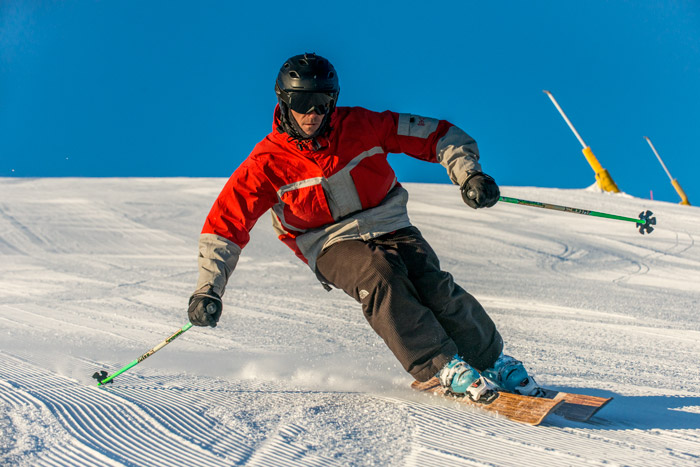



The ski industry’s new trend is a blast from the past. From wood cores to bamboo sidewalls and wooden topsheets, a small number of ski and snowboard shapers have turned to wood for its undeniable aesthetic, sustainable potential and penchant for performance.
Of course, skis have been made with wood since their invention, the oldest ones dating back to several thousand years BC. Starting in the 1950s, however, wood was traded for synthetic materials: first aluminum alloys and eventually, in more recent years, lighter layers of fiberglass and carbon fiber. With featherweight carbon skis and whacky camber profiles, it’s safe to say that ski tech has never been more advanced.

: Patrick Nelson
While many of today’s top skis still rely on wood cores, these small boutique shapers are working to integrate wood into more and more facets of the ski. That said, can these new wood models compete with their carbon compatriots? Certainly when it comes to the aesthetic. But according to the shapers, they can compete performace-wise as well.
Having worked as a “rider, instructor, coach, trainer, guide and shaper,” Mikey Franco knows a thing or two about snowboards. After a serious boarding injury in Japan, he met with the mythical Taro Tamai, founder of the famed surf-inspired snowboard company Gentemstick. Motivated by the practical beauty of Tamai’s designs, Franco started his own snowboard brand. Based in Jackson Hole, Wyoming, in the shadow of the Tetons, Franco Snowshapes now produces some of the world’s top-quality handmade wooden snowboards. Since its inception, the company has been recognized for its striking wood veneers and attention to environmental issues.

: Patrick Nelson
Surrounded by Jackson’s pristine wilderness, Franco knows firsthand how important the environment is to the outdoor community. His team sources wood from standing dead trees and beetle-killed whitebark pine from the local ski resort. Though he uses maple, oak, bamboo and other varieties of wood, he favors whitebark pine because of its significance in the Greater Yellowstone ecosystem. “[Whitebark pine trees] are dying at an unprecedented rate and this has a direct influence on Grizzly Bears and Clarks Nuthatch birds, as it is a staple food source for both,” he said. The disappearance of such iconic species could wreak havoc on fragile ecosystems. Franco uses Whitebark in his boards to draw attention to the importance and beauty of these trees. According to Franco, using wood as an awareness tool and eco-friendly material “can be the most responsible way to build a board.”
Responsible as it may be, using wood comes with its own challenges. Due to the whitebark’s spiral growth pattern, it can be extremely difficult to find trees with un-checked (cracked) wood. When Franco’s team does find a suitable tree, they remove the middle third of the tree and leave the bottom and top portions at the site to regenerate back into the soil. This leaves Franco with less usable material, but is healthier for the earth. In addition to the difficulty of finding workable trees, the manufacturing process isn’t exactly easy either. Each wood snowboard is totally unique and can take up to six weeks to build. However, according to Franco, the quality is unparalleled. Wood absorbs vibration extremely well, which “imparts a feeling of stability and power that you cannot achieve with plastic,” he said.
Caleb Baukol, Ski Shaper® at Big Wood Skis, is also in the sliding-on-wood industry and approaches his craft with the eye of an artist. To Baukol, skis are meant to be functional and beautiful, like guitars and violins. Just as concert violinists are drawn to the gorgeous hardwood and purposeful curves of a handcrafted instrument, Baukol hopes that dedicated skiers feel a connection to his wood skis. Instead of launching his styles in ski shops like many brands, he holds openings in art galleries to display skis made from maple, walnut and even exotic species like African zebrawood.

: Michael Stolp-Smith
While they may be displayed artfully on gallery or living room walls, don’t be fooled – Big Wood skis are built for finesse and power. Baukol tunes his skis to “world cup perfection”, and crafts them to last for years. “I make skis that have hand-me-down quality,” he said, “[so] kids can now go heli-skiing with their parents.” A perk of using wood topsheets is their timeless quality. Whereas bigger companies change the graphic of their ski models every year, wood, it seems, will never be out-of-date. By getting them revarnished from time to time, skiers who make the Big Wood Ski investment get their money’s worth.
And what an investment it is. Big Wood Skis’ 100% custom made skis can ring up over four grand, a price tag that’s undoubtedly hefty for those in the ski-bum world. In an effort to give back, however, Big Wood Skis donates 5% of profit to the Ebenezer Orphanage in Zambia for skis with African wood topsheets. For American-sourced wood, he gives 5% to Camp Rainbow Gold, a camp for kids with terminal cancer. Baukol also makes an effort of hiring local kids to work with him and complete their senior projects. “I’ve worked with every school in the area,” he said.

: Michael Stolp-Smith
Caleb Baukol believes the popularity of wooden topsheets will continue to rise. Boutique ski companies are quickly forming, and like the microbrew industry, might soon be bought up by bigger companies. However, he thinks it’s likely that the pricier handcrafted models will stay local, sticking with the ever-growing “know your farmer” concept in communities.
Due to the eco-friendly and locally-sourced aspect of wooden skis, along with the beauty and quality of the gear, wood skis and snowboards are definitely something to think about. Consider them performance-driven, aesthetically beautiful pieces of functional art.
Maybe just don’t look too hard at the price tag.
Seriously considering a pair?
Franco Snowshapes and Big Wood Skis aren’t the only ones out there utilizing wood to craft custom wood skis. Companies like Colorado’s Meier and Oregon’s SnoPlanks are noteworthy manufacturers of these decidedly niche products. If you’re going to really consider purchasing a pair of wood skis or a wood snowboard, do a little digging: your favorite ski town just might have a custom shaper.